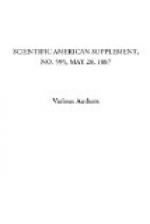Again, it is certain that no molecule can perform two sets of vibrations, two separate movements, at the same time, any more than it can be in two places at the same time.
When a band of music is playing, the molecule is supposed to make a complex vibration, a resultant motion of all acting influences, which the ear is supposed to analyze. It remains for the mathematician to show how a molecule influenced by twenty or more degrees of applied energy, and twenty or more required number of frequences of vibration at the same time, can establish a resultant motion which will transmit the required pitch, intensity, and timbre of each instrument.
When a molecule is acted on by various forces, a resultant motion is unquestionably produced, but this would only tend to send the molecule forward and back in one direction, and, in fact, a direction it might have taken in the first place if hit properly.
How any resultant can be established as regards the time necessary for the molecule to take so as to complete a full vibration for the note C_{11}, which requires 1/16 of a second, and for other notes up to C’’’’’, which only requires 1/4176 of a second, as when an orchestra is playing, is certainly beyond human comprehension, if it is not beyond the “transcendental mathematics” of the present day.
Unquestionably, the able mathematicians Lord Rayleigh, Stokes, or Maxwell, if the problem was submitted to them, would start directly to work, and deduce by so called “higher mathematics” the required motions the molecules would have to undergo to accomplish this marvelous task—the same as they have established the diameter of the supposed molecules, their velocity, distance apart, and number of bombardments, without any shadow of positive proof that any such things as molecules exist.
As S. Caunizzana has said: “Some of the followers of the modern school push their faith to the borders of fanaticism; they often speak on molecular subjects with as much dogmatic assurance as though they had actually realized the ingenious fiction of Laplace, and had constructed a microscope by which they could detect the molecule and count the number of its constituent atoms.”
Speaking of the “modern manufacturers of mathematical hypotheses,” Mattieu Williams says: “It matters not to them how ‘wild and visionary,’ how utterly gratuitous, any assumption may be, it is not unscientific provided it can be vested in formulae and worked out mathematically.
“These transcendental mathematicians are struggling to carry philosophy back to the era of Duns Scotus, when the greatest triumph of learning was to sophisticate so profoundly an obvious absurdity that no ordinary intellect could refute it.... The close study of pure mathematics, by directing the mind to processes of calculation rather than to phenomena, induces that sublime indifference to facts which has characterized the purely mathematical intellect of all ages.”




